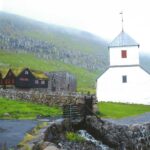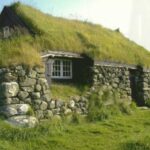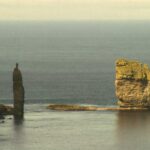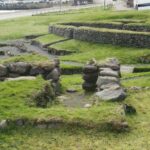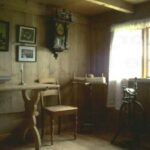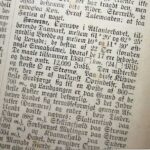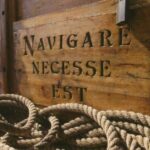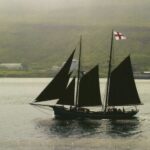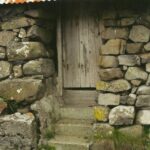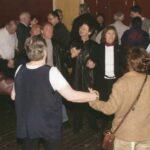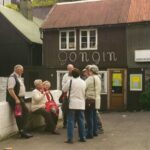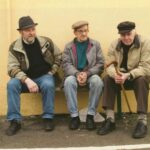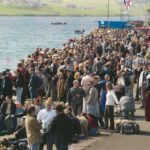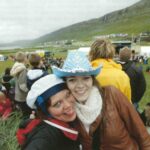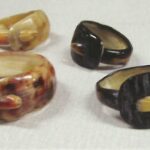Many and not least great festivals in a mix of the traditional and the modern are a characteristic of Faroe folk culture in our time. They follow the seasons of the year.
The short summer is marked by outdoor festivals and sports and cultural events. In the course of two intense months at least 15 major public arrangements are held. The season begins usually in late May and finishes with the largest of all the celebrations — Ólavsøka, held in the days around 29th July in the capital Tórshavn.
The sports events are regional occasions with national/local elements turning on the high points of the rowing boat races with the traditional Faroe boats. Here regions and villages compete just as much as each rowing team. In the groups of smaller boats both men and women race, while only men make up the crews of the bigger boats. There is much local prestige in these competitions, and the bigger boats are often named after the village or island they belong to.
This type of sports event has the character of a holiday with well dressed participants especially while the rowing races take place in the daytime. The flag is hoisted, the young people in their sport club dress walk in procession through the village, speeches are made, and the band plays. There is a festival service in the town church, the Christian congregations hold their outdoor meetings, there are concerts, and artists exhibit their works. There are jumbo sales, fairs for children and much else. The Faroe chain dance is a must in the evening and night in competition with modem dancing.
In contrast with the village events the new music festivals are not local. They are arranged in the internation¬al rhythmic festival tradition, prefer¬ably with popular foreign names at the top of the billboards and otherwise in international rhythmic musical style. The festivals are commercial, while the village fetes are held and expected to earn needed money for the local sports clubs and cultural life. There is not primarily local talent performing at the music festivals, and there is intense competition to make it up on to the stage.
The festivals have become competitors of the traditional village fetes. But both sorts of festive events are popular. With the excellent traffic connections of today it is no problem to travel from one arrangement to another. As the population of the Faroes is under 50.000, one may say that the relative participation in all these happenings is greater here than elsewhere.
Two holidays which are also celebrated is the Flag Day on April 25, with processions and official speeches on the symbols of the Flag and national issues, and Grækarismessa, held on March 12 on similar lines, presaging the advent of spring.
The festive season of the summer ends on 29th July with the great national festival, Ólavsøka. Its name derives from King Olav the Holy of Norway, who is said to have died on this date in the important battle of Stiklestad at Trondheim in the year 1030. Ólavsøka is only celebrated in Tórshavn, but it is nevertheless the great common festive event of all Faroese. Long before any amount of people lived at the place where the capital Tórshavn later sprang up, Ólavsøka was celebrated here.
Ólavsøka can be seen as the fusion of several holidays and festive events and has proved its ability to survive time and taste through centuries. It is a political event, church holiday, sports meeting, market, festival, popular feast, family party and much more.
The celebrations begin the day before with a colourful procession headed by a brass band through the streets of the town, official opening speech and concert just after midday. In the afternoon there are sports competitions and — of course — rowing races in the harbour as the pinnacle of prestige and excitement. People are dressed in national costume or other smart clothes. In the evening there are concerts and dances into the early hours. The following day starts under even more formal pomp and circumstance. The members of Parliament, of the clergy and of the senior civil service walk in procession from Parliament House to a special service at the Cathedral. As a kind of initiating rite a newly ordained clergyman delivers the sermon. After the service the procession returns to Parliament House, where the Løgmaður (lit: “lawman”, today: PM) opens the parliamentary session with a state of the nation speech and the government’s plans. The same day the ministers of the Church convene at the Bishop’s residence. The rest of the day there are more sports events, concerts, performances of all kinds, entertainment for children, fairs, exhibitions, religious meetings in the open, all in a lively mixture. Around midnight thousands of people gather for an hour or so in the centre of town for a sing-song, and the merry-making continues as long into the night as one has the stamina for.
The autumn and the time until Christmas is the season of the big private parties and social get-togethers of all kinds. They are of course indoor events due to the weather at that time of year. The biggest private parties are the weddings. They fit in well with the traditions of old, when great private feasts for easily explained reasons were held at harvesting time in autumn. With modern food preservation techniques people are less dependent upon the season regarding fresh food. But shorter days and in particular longer nights are well suit¬ed for the major indoor celebrations. And a real wedding in Faroe is no small arrangement. It is not unusual with 1—300 guests at a wedding, even if 100-150 guests is more usual.
Of other private parties of a certain size one ought to mention the round birthdays. Until a couple of generations back it was highly uncommon to celebrate birthdays, especially relatively young people’s. Nowadays they celebrate both the 30th and even more so the 40th birthdays with a gigantic party the size of a wedding. Stag parties are coming into use in the same bizarre forms as are known in other places.
And then there are the club, asso-ciation and societal celebrations. All sorts of clubs arrange an annual party of considerable dimensions, and some of them grow into the dominant social event of the season.
A typical and a feature of note to outsiders about Faroe festive tradition is the sing-along which may go on for hours. It is an adaptation of the older village festive tradition. Major feast were in earlier times a communal affair in each township once a year. The main event was the Faroe chain dance and informal social intercourse between the villagers and guests at a time when adverse travel conditions only permitted rare visits by relatives, friends and acquaintances in other settlements. Major parties of this type demanded considerable resources in scanty times. In our day neither transport nor money is a problem, but the parties remain. Now the emphasis of the feast has moved to the food and the table, which make up the larger part of the events. People mill around the table(s) for 7-8 hours and perhaps longer. One cannot only eat for that long, and as a substitute for the earlier social house-calling in the village, the communal sing-song takes place at table. Song leaflets lie at every plate, and a toast master presides over the sing-along, perhaps with the help a musical instrument. For an outsider it may at times seem like a trial to sit down for hours just singing, but the Faroese do it willingly and with zest. The repertoire is from the international song treasure, classical national or poetic songs, short ballads, occasional poems to the wedded couple or birthday boy/girl or in celebration of the club, interspersed with well known songs of entertainment and popular pop-songs.
In summary communal singing is perhaps the most characteristic feature of the modern Faroe festive tradition. It seems to be a custom in steady development, and the song leaflet at the table tends to get ever thicker with time. Likewise the relatively new custom of ending Olavsøka with communal singing in the centre of Tórshavn has proved to be very popular. For an hour 5 – 6000 people gather to sing together. The atmosphere is phenomenal and unique, also in grey and rainy weather. A magic moment which can hardly be described in words.
Hand Made and Meaningful
The Alv Shop in the centre of Tórshavn, next to the Town Hall, sells articles hand made by handicapped people. Most of the goods we sell are hand crafted. Much is knitwear and some woven garments, i.a. aprons and shawls for the Faroe national costume. Other artifacts, for instance the pilot whale knife, brandy glasses of horn, bracelets, necklaces, amulets etc. are made of whale tooth and Faroe stone as well as silver jewelry and horn ornaments.




